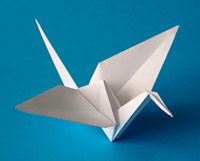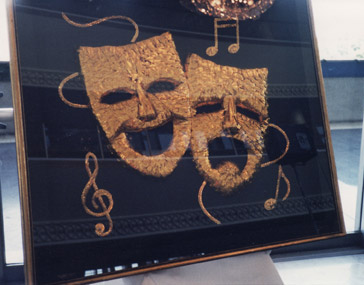
Why I wrote 1001 Cranes
 About origami cranes...
About origami cranes...
Every weekend when I was young, my parents went to a local bowling alley to participate in a bowling league for working gardeners. My friends, other children of gardeners, and I were on our own. Sometimes we pulled on the handle of vending machines to see if extra change would come out (can you believe that they used to sell cigarettes in vending machines?). Sometimes we spied on the hustlers inside of the pool hall. And sometimes I made origami cranes. My mother had a Japanese instructional book that showed how to fold not only cranes, but hats, squirrels, boxes, and penguins. I loved to do arts and crafts, and many times, I folded while listening to the thunder of bowling pins falling.
About a thousand and 1001 cranes...
I'm fascinated by the ways different generations of people have passed down traditions, changed them, and made them into their own.
The 1001 crane display is one such cultural phenomenon in the Japanese American community. In preparation of a friend's or relative's wedding, members of the wedding party may get together to fold gold cranes for a special wall display. (Usually the cranes are formed to create the kanji, or Chinese character, for love or happiness. Sometimes they are arranged into the family crest.)
The creation of these displays is not a Japanese practice, but a Japanese American one. Of course, however, Japan has a long tradition of folding of a thousand cranes. The first known "how to" book, in fact, was created in 1797 in Japan. You can see the diagrams and illustrations here. According to legend, the folding of a thousand cranes would result in the granting of a wish by a mystical crane.
The crane, which appears in many Japanese folk tales, holds special meaning for the Japanese. The bird can represent long life, fidelity, and peace.
Senbazuru, or a thousand cranes, became an especially important symbol to represent peace in connection with Sadako Sasaki, the young girl from Hiroshima who eventually died from radiation sickness from the atomic bomb. While she was struggling with her illness, her friends and families folded a thousand cranes for her to get better. Even though she didn't survive, senbazuru lived in the hearts of people all over the world.
From the 1970s, the Japanese American community took this image of a thousand cranes, and put their own unique twist on it. They began creating displays of 1001 cranes, the extra one for good luck. It's about celebration and joy.
Many Japanese Americans have been in the United States for four and even five generations. Most cannot speak Japanese. But families still fold 1001 cranes for weddings and retirement parties.
Although some of the cultural values Japanese Americans have are hard to identify, the 1001 crane displays are one visible way that this community celebrates its heritage. Of course, as time passes, even this practice may disappear.
This is my friends' 1001 crane display at their wedding. They both are involved in theatre and have started the Grateful Crane Ensemble.

About divorce...
I first set out to write a women's novel about marriage, but soon discovered that I was writing a book about relationships and divorce from a tween's point of view. This actually happens to me quite often. I slowly learn what I'm trying to say after I've attempted to write my story.
My own parents are still married and I'm happily married as well. So in that sense, 1001 Cranes is not autobiographical. But I can imagine how hard it would be if my parents separated. And I know firsthand how painful heartbreak is. I found it easy to step into Angela's shoes and I hope you are able to, too.
